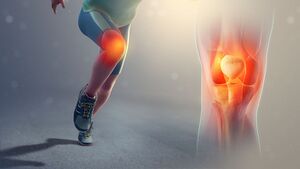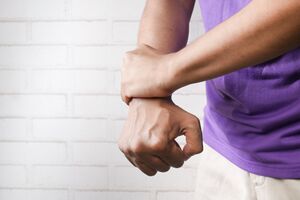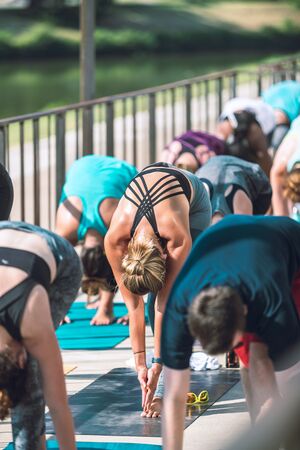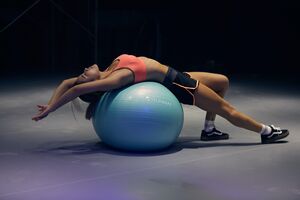Osteoarthritis in Young People: Difference between revisions
No edit summary |
No edit summary |
||
| (25 intermediate revisions by 7 users not shown) | |||
| Line 1: | Line 1: | ||
<div class="editorbox"> | <div class="editorbox"> | ||
'''Original Editor '''- [[User:Anna Jansma|Anna Jansma]] | '''Original Editor '''- [[User:Anna Jansma|Anna Jansma]] | ||
'''Top Contributors''' - {{Special:Contributors/{{FULLPAGENAME}}}} | '''Top Contributors''' - {{Special:Contributors/{{FULLPAGENAME}}}}
| ||
</div> | </div> | ||
== Definition | == Definition == | ||
[[File:Runners-knee SAG.jpeg|right|frameless]] | |||
Osteoarthritis | [[Osteoarthritis]] (OA) is one of the most devastating [[Chronic Disease|chronic condition]]<nowiki/>s that affect people around the world. Although the usual population associated with the condition is the [[Older People - An Introduction|elderly]] (who are mostly inactive), [[Athletes with difficult or longstanding neuromusculoskeletal symptoms|athlete]]<nowiki/>s and younger individuals are also susceptible. | ||
* Depending on the population, the etiology may differ; injuries, occupational activities, and [[obesity]] appear to be the most common causes of OA in young and athletic populations. | |||
[[ | * Diagnosing OA in athletes and young individuals is sometimes challenging because of their increased [[Pain Behaviours|pain]] tolerance. | ||
* However, the treatment of OA in these populations does not differ from its management in the general population<ref name=":1">Amoako AO, Pujalte GG. [https://www.ncbi.nlm.nih.gov/pmc/articles/PMC4039183/ Osteoarthritis in young, active, and athletic individuals.] Clinical Medicine Insights: Arthritis and Musculoskeletal Disorders. 2014 Jan;7:CMAMD-S14386.Available: https://www.ncbi.nlm.nih.gov/pmc/articles/PMC4039183/<nowiki/>(accessed 17.10.20210</ref>. | |||
== Potential Causes == | |||
There are a whole range of potential causes of osteoarthritis in young adults (14-40). These include – | |||
* Leading a sedentary (non-active) lifestyle | |||
* | * Poor [[posture]] when sitting for long periods | ||
* | * Heavy [[lifting]] (potentially with poor technique, but not necessarily) | ||
* | * Doing an office job with large amounts of sitting at a desk/ computer | ||
* | * Being overweight or clinically obese | ||
* | * Being very active ([[Assessment of Running Biomechanics|running]] lots of marathons for example) | ||
* Playing impact sports such as rugby or football | |||
* [[Sport Injury Classification|Joint injuries]] | |||
* Birth defects such as [[Hip Dysplasia|hip dysplasia]] or different length legs | |||
* [[Hormones|Hormone]] disorders that affect growth | |||
* [[Diabetes]] | |||
* Osteoarthritis in the family<ref name=":0">Ackerman IN, Kemp JL, Crossley KM, Culvenor AG, Hinman RS. [https://www.jospt.org/doi/full/10.2519/jospt.2017.7286 Hip and knee osteoarthritis affects younger people, too.] journal of orthopaedic & sports physical therapy. 2017 Feb;47(2):67-79.Available: https://www.jospt.org/doi/full/10.2519/jospt.2017.7286<nowiki/>(accessed 17.10.2021)</ref><ref>Oddis CV. [https://www.sciencedirect.com/science/article/abs/pii/S0002934397895411 New perspectives on osteoarthritis]. The American journal of medicine. 1996 Feb 26;100(2):10S-5S.Available: https://www.sciencedirect.com/science/article/abs/pii/S0002934397895411<nowiki/>(accessed 17.10.2021)</ref> | |||
== | == Assessment == | ||
[[File:Towfiqu-barbhuiya-3AsiVDsZnHg-unsplash.jpeg|right|frameless]] | |||
Assessment of OA in younger people should focus on a: | |||
* Patient-centred history, | |||
[[ | * Comprehensive physical examination, | ||
* [[Outcome Measures|Performance-based measures]] | |||
* Patient-reported outcome measures to enable monitoring of symptoms and function over time. | |||
Referral for [[Diagnostic Imaging for Lower Extremity|imaging]] should be reserved for people presenting with atypical signs or symptoms that may indicate diagnoses other than OA. | |||
== Treatment Approach == | |||
[[File:Nate-johnston-2gBpsNuHcyA-unsplash.jpeg|right|frameless]] | |||
The treatment of OA in these populations does not differ from its management in the general population.<ref name=":1" /> See | |||
[[:Category:Osteoarthritis|Category:Osteoarthritis]] | |||
Nonpharmacological approaches are core strategies for the management of OA in younger people, and these include appropriate disease-related education, activity modification (including for [[Work-Related Musculoskeletal Injuries and Prevention|work-related tasks]]), physical therapist- prescribed [[Therapeutic Exercise|exercise]] programs to address identified physical impairments, and weight control or weight loss. | |||
# High-quality evidence has shown no benefit of [[Meniscal Repair|arthroscopy]] for knee OA, and there are no published clinical trials to support the use of hip arthroscopy for OA.<ref>Brophy RH, Fillingham YA. AAOS clinical practice guideline summary: management of osteoarthritis of the knee (nonarthroplasty). JAAOS-Journal of the American Academy of Orthopaedic Surgeons. 2022 May 1;30(9):e721-9.</ref> | |||
# Referral for joint-conserving or joint replacement surgery should be considered when nonpharmacological and pharmacological management strategies are no longer effective.<ref name=":0" /> | |||
== Prevention == | == Prevention == | ||
[[File:Mr-lee-f4RBYsY2hxA-unsplash.jpeg|right|frameless]] | |||
The prevention of development of [[osteoarthritis]] in the adolescent can be achieved by reducing risk factors. | |||
# Physiotherapists can promote the maintenance of a healthy weight, low-impact activities (eg [[aquatherapy]]) giving exercises to improve joint stability to prevent joint injuries.<ref name="nicholson">Nicholson S. et al. Reducing Premature Osteoarthritis in the Adolescent Through Appropriate Screening. (2009) Journal of Pediatric Nursing, 24, 69-74 (B)</ref> They can have influence by preventing further progression or complications of a disorder and improving the patient’s self-efficacy.<ref name="rds">van Doormaal MC, Meerhoff GA, Vliet Vlieland TP, Peter WF. A [https://onlinelibrary.wiley.com/doi/abs/10.1002/msc.1492 clinical practice guideline for physical therapy in patients with hip or knee osteoarthritis]. Musculoskeletal Care. 2020 Dec;18(4):575-95. Availabe: https://onlinelibrary.wiley.com/doi/abs/10.1002/msc.1492<nowiki/>(accessed 23.10.2021)</ref> | |||
# In case of malalignments ([[Leg Length Discrepancy|leg-length]] discrepancy, varus/valgus, etc.) young patients should be referred to a podiatrist for [[Introduction to Orthotics]] to prevent the development of OA (in the hip or knee). | |||
# During the very early stages, physiotherapists can guide on strengthening the muscles of the knee joint which can reduce further damage to joint. | |||
== References == | == References == | ||
| Line 100: | Line 65: | ||
[[Category:Osteoarthritis]] | [[Category:Osteoarthritis]] | ||
[[Category:Paediatrics]] | [[Category:Paediatrics]] | ||
[[Category:Paediatrics - Conditions]] | |||
Latest revision as of 02:21, 7 December 2023
Original Editor - Anna Jansma
Top Contributors - Lucinda hampton, Oyemi Sillo, Claudia Karina, Kim Jackson, Lauren Lopez, Nupur Smit Shah, Lauren Heydenrych, Reem Ramadan, Anna Jansma and Evan Thomas
Definition[edit | edit source]
Osteoarthritis (OA) is one of the most devastating chronic conditions that affect people around the world. Although the usual population associated with the condition is the elderly (who are mostly inactive), athletes and younger individuals are also susceptible.
- Depending on the population, the etiology may differ; injuries, occupational activities, and obesity appear to be the most common causes of OA in young and athletic populations.
- Diagnosing OA in athletes and young individuals is sometimes challenging because of their increased pain tolerance.
- However, the treatment of OA in these populations does not differ from its management in the general population[1].
Potential Causes[edit | edit source]
There are a whole range of potential causes of osteoarthritis in young adults (14-40). These include –
- Leading a sedentary (non-active) lifestyle
- Poor posture when sitting for long periods
- Heavy lifting (potentially with poor technique, but not necessarily)
- Doing an office job with large amounts of sitting at a desk/ computer
- Being overweight or clinically obese
- Being very active (running lots of marathons for example)
- Playing impact sports such as rugby or football
- Joint injuries
- Birth defects such as hip dysplasia or different length legs
- Hormone disorders that affect growth
- Diabetes
- Osteoarthritis in the family[2][3]
Assessment[edit | edit source]
Assessment of OA in younger people should focus on a:
- Patient-centred history,
- Comprehensive physical examination,
- Performance-based measures
- Patient-reported outcome measures to enable monitoring of symptoms and function over time.
Referral for imaging should be reserved for people presenting with atypical signs or symptoms that may indicate diagnoses other than OA.
Treatment Approach[edit | edit source]
The treatment of OA in these populations does not differ from its management in the general population.[1] See
Nonpharmacological approaches are core strategies for the management of OA in younger people, and these include appropriate disease-related education, activity modification (including for work-related tasks), physical therapist- prescribed exercise programs to address identified physical impairments, and weight control or weight loss.
- High-quality evidence has shown no benefit of arthroscopy for knee OA, and there are no published clinical trials to support the use of hip arthroscopy for OA.[4]
- Referral for joint-conserving or joint replacement surgery should be considered when nonpharmacological and pharmacological management strategies are no longer effective.[2]
Prevention[edit | edit source]
The prevention of development of osteoarthritis in the adolescent can be achieved by reducing risk factors.
- Physiotherapists can promote the maintenance of a healthy weight, low-impact activities (eg aquatherapy) giving exercises to improve joint stability to prevent joint injuries.[5] They can have influence by preventing further progression or complications of a disorder and improving the patient’s self-efficacy.[6]
- In case of malalignments (leg-length discrepancy, varus/valgus, etc.) young patients should be referred to a podiatrist for Introduction to Orthotics to prevent the development of OA (in the hip or knee).
- During the very early stages, physiotherapists can guide on strengthening the muscles of the knee joint which can reduce further damage to joint.
References[edit | edit source]
- ↑ 1.0 1.1 Amoako AO, Pujalte GG. Osteoarthritis in young, active, and athletic individuals. Clinical Medicine Insights: Arthritis and Musculoskeletal Disorders. 2014 Jan;7:CMAMD-S14386.Available: https://www.ncbi.nlm.nih.gov/pmc/articles/PMC4039183/(accessed 17.10.20210
- ↑ 2.0 2.1 Ackerman IN, Kemp JL, Crossley KM, Culvenor AG, Hinman RS. Hip and knee osteoarthritis affects younger people, too. journal of orthopaedic & sports physical therapy. 2017 Feb;47(2):67-79.Available: https://www.jospt.org/doi/full/10.2519/jospt.2017.7286(accessed 17.10.2021)
- ↑ Oddis CV. New perspectives on osteoarthritis. The American journal of medicine. 1996 Feb 26;100(2):10S-5S.Available: https://www.sciencedirect.com/science/article/abs/pii/S0002934397895411(accessed 17.10.2021)
- ↑ Brophy RH, Fillingham YA. AAOS clinical practice guideline summary: management of osteoarthritis of the knee (nonarthroplasty). JAAOS-Journal of the American Academy of Orthopaedic Surgeons. 2022 May 1;30(9):e721-9.
- ↑ Nicholson S. et al. Reducing Premature Osteoarthritis in the Adolescent Through Appropriate Screening. (2009) Journal of Pediatric Nursing, 24, 69-74 (B)
- ↑ van Doormaal MC, Meerhoff GA, Vliet Vlieland TP, Peter WF. A clinical practice guideline for physical therapy in patients with hip or knee osteoarthritis. Musculoskeletal Care. 2020 Dec;18(4):575-95. Availabe: https://onlinelibrary.wiley.com/doi/abs/10.1002/msc.1492(accessed 23.10.2021)










